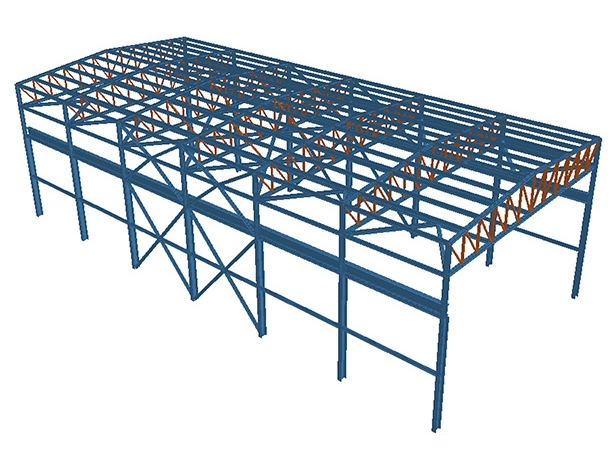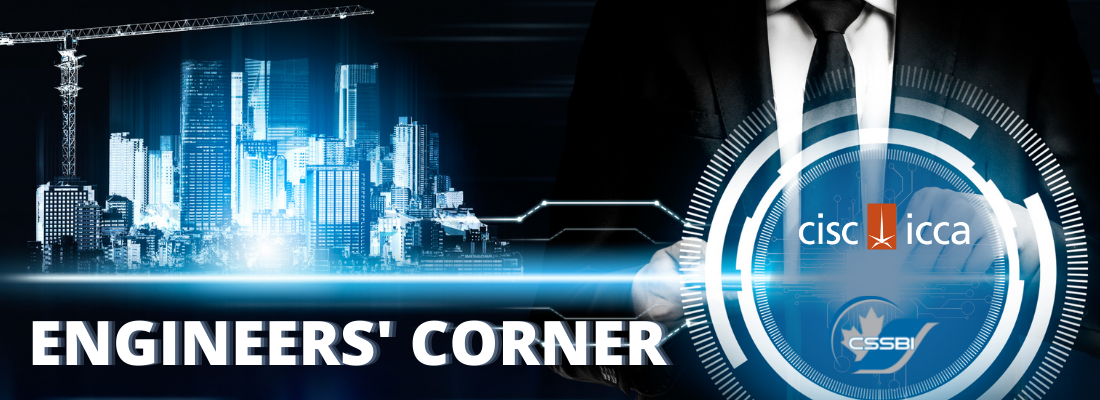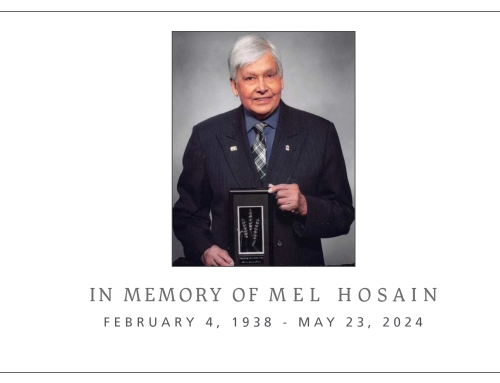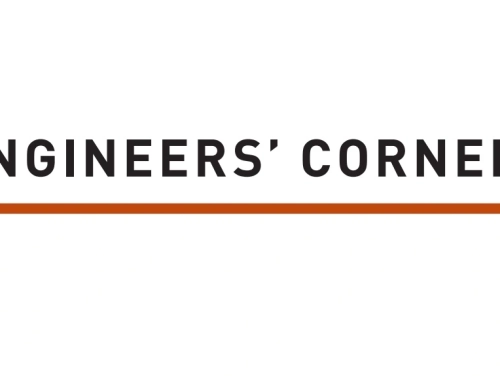The updated, second edition of Industrial Steel Structures, by R.A. MacCrimmon and J. Richard, was published earlier this year. It can be obtained from the CISC Steel Store (https://steelstore.cisc-icca.ca/). See Figure 1.
This CISC publication was expanded from 148 pages (in the first edition) to 201 and illustrates the design of a typical mill building carrying two 40‑tonne cranes (see Figures 2 and 3). The example frame consists of stepped columns with a 24-m-span Pratt truss supporting the roof and lateral loads. Structural aspects covered in this publication include design standards, toughness and temperature, coatings, standing-seam roofs, rehabilitation and boiler support structures.
Industrial Steel Structures is based on the National Building Code of Canada (NBC 2015) and CSA Standard S16:19 (Design of steel structures). Further information may be found in the CISC publication entitled, Crane-Supported Steel Structures – Design Guide, 4th Edition, by R.A. MacCrimmon.
The list of references in Chapter 10 has doubled in size, has been fully updated and provides information for industrial buildings and non-building structures on topics such as: wind and seismic loads, crane buildings, cranes and crane beams, fatigue, stability, base plates, connections to concrete, general plate and shell structures, tanks, bins, hoppers, silos, ductwork, stacks and pressure vessels.
See Table 1 below for the Table of Contents.

Figure 1
Industrial Steel Structures, Second Edition

Figure 2
Building Geometry – Roof Truss

Figure 3
Building Geometry – Stepped Columns
Table of contents
Foreword ……………………………………………………………………………………………………….. iii
Preface…………………………………………………………………………………………………………… iv
1 – CODE PROVISIONS ………………………………………………………………………………………… 1
1.1 – Introduction …………………………………………………………………………………………. 1
1.2 – Limit States Design …………………………………………………………………………………. 1
1.3 – Live Loads Due to Use and Occupancy ………………………………………………………… 2
1.4 – Wind Loads ………………………………………………………………………………………….. 2
1.5 – Earthquake Loads and Effects …………………………………………………………………… 2
1.6 – Seismic Design Mitigating Measures ………………………………………………………….. 3
1.7 – Design Requirements for Steel Structures …………………………………………………… 4
1.8 – Design Requirements for Special Structures ………………………………………………… 4
1.9 – Other Regulations ………………………………………………………………………………….. 5
1.10 – Problematic Issues for Industrial Structures ……………………………………………….. 7
2 – DESIGN STANDARDS …………………………………………………………………………………….. 11
2.1 – Introduction ……………………………………………………………………………………….. 11
2.2 – Overview of S16:19, a Limit States-Based Material Design Standard ………………… 11
2.3 – Scope of S16 in Relation to Industrial Structures …………………………………………. 12
2.4 – Notional Loads …………………………………………………………………………………….. 13
2.5 – Segmented Columns …………………………………………………………………………….. 13
3 – TOUGHNESS AND TEMPERATURE …………………………………………………………………… 17
3.1 – Introduction ……………………………………………………………………………………….. 17
3.2 – Toughness ………………………………………………………………………………………….. 17
3.3 – Low Temperatures ……………………………………………………………………………….. 18
3.4 – Brittle Fracture – Strategies for the Industrial Building Designer ……………………… 19
3.5 – High Temperatures ………………………………………………………………………………. 20
3.6 – High Temperatures – Strategies for the Designer …………………………………………. 20
3.7 – Lamellar Tearing ………………………………………………………………………………….. 22
4 – COATINGS FOR STRUCTURAL STEEL FOR INDUSTRY …………………………………………….. 31
4.1 – Introduction and Definitions …………………………………………………………………… 31
4.2 – Priorities for Industrial Buildings ……………………………………………………………… 31
4.3 – Codes and Standards – Canadian Practice ………………………………………………….. 31
4.4 – When Not to Paint ……………………………………………………………………………….. 32
4.5 – Weathering Steel …………………………………………………………………………………. 32
4.6 – Special Circumstances …………………………………………………………………………… 32
4.7 – Galvanizing …………………………………………………………………………………………. 33
4.8 – Surface Preparation ……………………………………………………………………………… 33
4.9 – Systems ……………………………………………………………………………………………… 34
4.10 – Choice of Materials …………………………………………………………………………….. 35
4.11 – Designing for Better Coating …………………………………………………………………. 35
4.12 – Specifications …………………………………………………………………………………….. 36
4.13 – Testing and Inspection …………………………………………………………………………. 36
4.14 – Costs ……………………………………………………………………………………………….. 37
4.15 – Useful Resources ………………………………………………………………………………… 37
5 – ROOFING SYSTEMS ……………………………………………………………………………………… 43
5.1 – Types of Roofing ………………………………………………………………………………….. 43
5.2 – Standing-Seam Roofs for Industrial Buildings ……………………………………………… 46
6 – ROOF FRAMING FOR TYPICAL INDUSTRIAL BUILDINGS ………………………………………… 53
6.1 – Introduction ……………………………………………………………………………………….. 53
6.2 – Truss Construction ……………………………………………………………………………….. 55
6.3 – Fire Safety ………………………………………………………………………………………….. 55
6.4 – Roof Slopes and Drainage ………………………………………………………………………. 55
6.5 – Seismic Issues ……………………………………………………………………………………… 55
7 – REHABILITATION AND UPGRADING OF EXISTING INDUSTRIAL STEEL STRUCTURES …….. 63
7.1 – Introduction ……………………………………………………………………………………….. 63
7.2 – Codes and Standards …………………………………………………………………………….. 63
7.3 – Inspections, Condition Surveys and Reporting …………………………………………….. 63
7.4 – Loads and Load Combinations …………………………………………………………………. 64
7.5 – Structural Modelling …………………………………………………………………………….. 65
7.6 – Reinforcing and Replacement …………………………………………………………………. 65
7.7 – Reinforcing and Existing Runway Beam …………………………………………………….. 65
7.8 – Reinforcing and Existing Column ……………………………………………………………… 66
7.9 – Welding to Existing Structures ………………………………………………………………… 66
8 – BOILER SUPPORT STRUCTURES ………………………………………………………………………. 69
8.1 – Introduction ……………………………………………………………………………………….. 69
8.2 – Unique Features ………………………………………………………………………………….. 69
8.3 – Challenges for the Structural Steel Designer ………………………………………………. 71
8.4 – Mitigation …………………………………………………………………………………………… 71
8.5 – Seismic Ties ………………………………………………………………………………………… 72
8.6 – References …………………………………………………………………………………………. 72
9 – DESIGN EXAMPLE ………………………………………………………………………………………… 75
9.1 – Building Design Example Overview and Basic Load Calculation……………………….. 75
9.2 – Support for Cladding …………………………………………………………………………….. 86
9.3 – Crane Runway Beam Design ………………………………………………………………….. 100
9.4 – Building Analysis Model and Seismic Analysis ……………………………………………. 137
9.5 – Roof Truss …………………………………………………………………………………………. 165
9.6 – Stepped Columns ……………………………………………………………………………….. 170
9.7 – Column Base Connection ……………………………………………………………………… 187
10 – REFERENCES …………………………………………………………………………………………… 195
Table 1
Table of Contents









